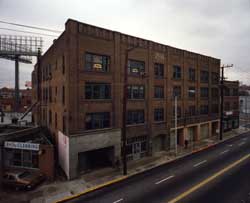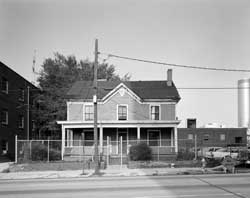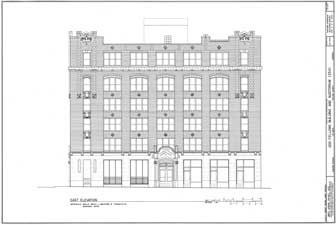Sweet Auburn Historic District
The documentation of the Sweet Auburn Historic District was completed by the Historic American Buildings Survey in 1979-1981 in order to assist in revitalization efforts. Field teams comprehensively recorded the Odd Fellows Building & Auditorium, the Herndon Building, and a number of commercial structures along a four block area of Auburn Avenue. These structures were built by African American entrepreneurs during the early decades of the twentieth century and represent significant contributions to the architectural and historical heritage of the Sweet Auburn area and the city of Atlanta, Georgia.
Community Prosperity
Since the middle of the nineteenth century, the Sweet Auburn neighborhood has functioned almost independently as a dynamic African American neighborhood within Atlanta, Georgia. Atlanta had long been a segregated city, and years of discrimination isolated the Sweet Auburn area- not physically, but socially and economically. To survive, the African American community developed its own network of social and religious institutions, business enterprises, and political organizations. The strength of the community was focused on the commercial district along Auburn.
The neighborhood evidenced strong growth and development between the years 1880 and 1970. "Sweet Auburn" was the name given the neighborhood by John Wesley Dobbs, a renowned African American community leader, who called it "the richest Negro street in the world." On the avenue, fewer constraints hampered black enterprises, and the "sweet brown honey" of commercial success made Sweet Auburn a source of great pride for Atlanta's African-American community. By the early twentieth century, the district was the center of African American economic, institutional, and cultural life in Atlanta and it was wealthier and more cohesive than many other Atlanta neighborhoods.
It is a sad irony that as racial tensions eased in Atlanta, Sweet Auburn declined. Many African Americans left the neighborhood, taking with them their businesses, thus sapping the local economy. Yet the history of Atlanta's black community is preserved in the physical context of the historic district. Sweet Auburn was designated a National Historic Landmark in 1976. In 1992 the National Trust for Historic Preservation recognized that it was one of America's 11 Most Endangered Historic Places. The Historic District Development Corporation was formed to facilitate renewal and improvement of the community without pricing lower-income residents out of the neighborhood.
Learn More
- HABS documentation of the Sweet Auburn Historic District (HABS GA-1170)
- HABS documentation of the Herndon & Atlantic Life Building (HABS GA-1170-A)
- HABS documentation of the Odd Fellows Building & Auditorium (HABS GA-1170-B)
- HABS documentation of 126-255 Auburn Avenue (HABS GA-1170-C)
- National Register of Historic Places Travel Itinerary: Atlanta, Georgia









